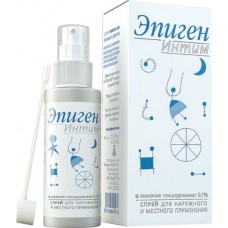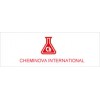Expiration date: 01/2025
Composition and form of release:
Spray for external and local use 1 fl.
activated glycyrrhizic acid 0.1%
excipients: malic acid fumaric acid ascorbic acid folic acid propylene glycol twin (polysorbate) purified water
in plastic bottles of 15 or 60 ml, complete with a spray nozzle for intravaginal use in a cardboard box 1 set.
Description of the dosage form:
The solution is light yellow to light brown in color, with a characteristic smell.
Pharmacokinetics:
When applied topically and topically, activated glycyrrhizic acid is deposited in the lesions. Systemic absorption is slow. The drug is found in the blood in trace amounts.
Description of pharmacological action:
The active ingredient of the drug Epigen intima is activated glycyrrhizic acid, obtained by extraction from vegetable raw materials (licorice root).
The immunostimulating effect is manifested by an increase in the number and activity of T-lymphocytes, a decrease in the concentration of Ig G and an increase in the concentration of Ig A and M. Activated glycyrrhizic acid significantly inhibits the release of kinins and the synthesis of PG by connective tissue cells in the inflammatory zone. The regenerating effect is due to the improvement of the repair of the skin and mucous membranes.
The anti-inflammatory activity of activated glycyrrhizic acid is combined with a stimulating effect on humoral and cellular immune factors.
Activated glycyrrhizic acid induces the formation of interferon, which is one of the components of its antiviral action.
Activated glycyrrhizic acid has an antiviral effect on different types of DNA and RNA viruses in vitro and in vivo (Varicella Zoster herpes simplex virus type 1 and 2 cytomegalovirus, various types of human papillomavirus, including oncogenic).
Activated glycyrrhizic acid interrupts the replication of viruses in the early stages, causes the release of the virion from the capsid, thereby preventing its penetration into the cells.
Activated glycyrrhizic acid inactivates these viruses in non-toxic concentrations for normally functioning cells. Mutant strains of viruses that are resistant to acyclovir and iodouridine are also highly sensitive to glycyrrhizic acid, as are non-mutant strains.
Indications:
- treatment of viral infection caused by the human papillomavirus, including asymptomatic isolation of the human papillomavirus of high oncogenic risk as part of combined and complex therapy
- treatment of viral infection caused by herpes simplex virus types I and II as part of complex therapy
- treatment of a viral infection caused by the Varicella Zoster virus (shingles) as part of a complex therapy
- treatment of viral infection caused by cytomegalovirus as part of complex therapy
- prevention of relapses of viral infections caused by herpes simplex virus types I and II, Varicella Zoster virus, human papillomavirus, cytomegalovirus
- prevention and treatment of genital warts and cervical pathology caused by human papillomavirus, cytomegalovirus
- prevention and treatment of conditions accompanied by a decrease in local immunity, including nonspecific vulvovaginitis, candida vulvovaginitis and bacterial vaginosis as part of complex therapy
- phenomena of discomfort in the genital area, accompanied by itching, burning and dryness, including after sexual intercourse
- phenomena of discomfort in the genital area, accompanied by itching, burning and dryness of the mucous membranes with insufficient ovarian function.
Contraindications:
Hypersensitivity to the components of the drug.
Use during pregnancy and lactation:
The drug is approved for use during the entire period of pregnancy and breastfeeding.
Side effect:
In rare cases, local allergic reactions are possible, sometimes in the form of contact dermatitis.
Drug interaction:
There was no interaction with the main groups of drugs used for additional treatment of these diseases (antibiotics and antiseptics, anti-inflammatory and painkillers).
At the same time, synergism was found with the simultaneous use of glycyrrhizic acid and other antiviral substances, in particular, derivatives of acyclovir, iodouridine, interferon and other immunomodulators.
Method of administration and dosage:
Intravaginal, external, and intraurethral. Before use, the cylinder must be shaken and kept in an upright position when used.
When applied externally, the drug is applied to the entire affected surface from a distance of 4-5 cm by 1-2 valve presses, which is the optimal therapeutic dose.
For intravaginal use of the drug, a special nozzle is attached. It is a hollow tube with a length of 7 cm, at one end of which there is a sprayer, at the other end there is a valve. Remove the valve from the spray bottle and put on the nozzle valve. The nozzle is then inserted into the vagina in the patient's "lying on her back" position.
Intravaginally, the drug is injected by 1-2 taps of the nozzle, which is the optimal therapeutic dose.
After application, it is necessary to remain in the "lying" position for 5-10 minutes. When used by men, in addition to external application, the drug is injected into the external opening of the urethra by 1-2 presses of the spray valve.
With papillomavirus infection:
- before removal of warts — 3 times a day for the entire period of etiotropic therapy
- against the background of destruction-5 times a day for 10 days or more before healing
- for the prevention of immediate relapses-3 times a day for 1 month.
To prevent the progression of papillomavirus infection: before and after sexual intercourse, as well as in the event of provoking factors-stress, fatigue, ARVI, violation of the microflora, taking antibiotics, cytostatics-3 times a day intravaginally and externally for the entire period of exposure to provoking factors.
In case of skin infection caused by the herpes simplex virus (including shingles): 6 times a day on the lesion for 5 days. With a persistent course of the infectious process, the treatment period is extended until the complete disappearance of the symptoms of the disease.
For genital herpes and cytomegalovirus infection: 5 times a day for 14 days externally and intravaginally, after stopping the relapse-externally and intravaginally 3 times a day for 10 days.
To prevent relapses of genital herpes and cytomegalovirus infection: externally and intravaginally from the 18-20 day of the menstrual cycle until the end of menstruation 2 times a day in the morning and in the evening.
For non-specific colpitis, bacterial vaginosis and Candida vulvovaginitis: intravaginally 3-4 times a day for 7-10 days. If necessary, the course of treatment is repeated after 10 days. In the event of provoking factors — ARVI, taking antibiotics, cytostatics - 3 times a day intravaginally and externally for the entire period of exposure to provoking factors.
With the phenomena of discomfort in the genital area, accompanied by itching, burning and dryness, including with insufficient ovarian function and after sexual intercourse: 2 times a day (morning and evening) for 2-3 weeks. In order to prevent discomfort, use regularly after sexual intercourse.
As a preventive antiviral agent, the drug is recommended to be used before and after sexual intercourse.
Special instructions:
The nozzle is washed with boiled water and soap and stored in the attached plastic packaging.
The design of the nozzle allows you to maintain the effect of uniform irrigation of the cervix and the walls of the vagina.
For use in a hospital setting, intravaginal irrigation with the drug in mirrors can be performed without a nozzle.
For effective action, no pre-washing of the application area is required.
In case of signs of intolerance, stop using the drug.


